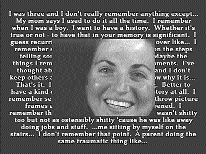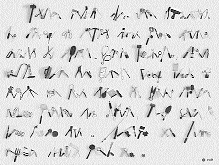At the time and space of interface
Virginia Baxter and Keith Gallasch do the interactive at Burning the Interface, Cybercultures and No Exit

Nino Rodriguez, Boy (United States, 1994)
Are galleries quite the right places for exhibitions like Burning the Interface, Cybercultures and the Luc Courchesne contribution to No Exit? You have to ask. At the MCA’s Burning the Interface at 11.30 on Saturday morning the room is already full of people quietly tapping away. What’s the alternative? The private booth? Appointments at your local gallery? Certainly some kind of ticket that allows a couple of visits seems to be indicated. It’s depressing to think the only solution is back home in front of your own computer because there are some pleasures in being with other people in a sea of CD ROMs—though not many. This artform would seem on the one hand to be the least social but, let’s face it, the more adventurous works will always need public space. The answer is some as yet unimagined place.
As with any art you can scan images but here it’s not just seeing that’s at stake but more the time of cinema, the textuality of books, the pleasures of sound and most importantly time to choose from a range of options. You’re likely to spend much longer with an engaging CD-ROM than a painting or a sculpture because it requires you to. And watching over other people’s shoulders is no fun for them or for you. With some, non-interactive works, like Peter de Lorenzo’s Reflections, Abstractions and Memory Structures all you do is watch as frames become flames, images unfold and fragment, transform through twelve minutes that slowly focus and transform and sometimes look like ‘pixelist’ paintings.
A room full of CD-ROMs and similar offerings is like being at a party where every person in the room is talking about something different and everyone is inviting you over to talk. So you move from machine to machine and you know the room is bound to contain a few bores who will never let you go. A couple of women are having trouble exiting from the jaws of the very insistent and confronting seedy-ROM Necro Enema Amalgamated in the corner. They’re trapped until we start to hover and they make their escape.
With Luc Courchesne’s Portrait One you feel you’d like to be alone. A young woman speaks intimately and offers you a set of responses and questions with which to address her. Courchesne’s other work Hall of Shadows for the No Exit exhibition at the Art Gallery of New South Wales, is like being in a room full of holograms and you know, because you heard it on the grapevine, that if you push the right buttons, you can get these laser-disc-video images to actually speak to one another. Just like the host at a real party. Somehow, these naturalistic/theatrical works are the most confronting because they are the least like paintings and the most like engaging with real people. And you need to be alone or nearly alone with them. A crowded gallery room reduces Hall of Shadows to four duets.
In another intimate work at the MCA’s Burning the Interface, Nino Rodriguez’ Boy, a woman offers you fragments of memories of her childhood “as a boy”, “as a tomboy”, when “my mother was always throwing picture frames at people”. As she speaks, her words unfold on the screen and you can click on an earlier word and phrase and she’ll repeat that passage. You don’t get into an exchange as you can in the Luc Courchesne, but by using the mouse you can get her to repeat and re-order what she has said. You, in turn, play with what she says, creating an even quirkier poetry of the everyday. There’s no animation, no collage, you simply choose to watch and listen to someone speak. You can even make her disappear and just read or listen to what she’s got to say. All she requires is that you be with her for a time.
There’s quite a lot of reading on offer on these CD-ROMs, though the kinds of reading experiences vary. Something like Jean-Louis Boissier’s exquisite Flora Petrinsularas needs an hour. It’s like reading a precious book in which words become flesh. The text comprises sixteen quotations from Jean-Jacques Rousseau’s The Confessions. You move from sexual encounters between 18th Century characters in Quick Time movies—breasts, faces, delicate clothing in surprisingly fine images—to a catalogue of plants in nature to close up specimens of the same that press against the screen. The urge to touch is irresistible. Who said we were mousebound? This one requires patience and a delicate hand. If you push too hard, you’ll just find yourself back with the relentless lapping of water over pebbles that lies behind every image and you’ll miss the eroticism of the work. Again, the human figures exert a personal directness—gazing into your eyes, flushed with near orgasm in a QuickTime loop of heavy breathing. Only when you think you encounter perhaps too obvious a connection between woman and nature do you feel the pull to another machine.

Eric Lanz, Manuskript (Switzerland/Germany, 1994)
You can read Erik Lanz’ delicate Manuskript like a visual encyclopaedia. It’s a collection of small images of hand tools that first look like rows of words until you move in closer, clicking on each tool to get a small movie with the sound of the object performing its function. That’s it. But what a pleasure as the everyday object and its sound and movement become epiphany
Bill Seaman offers a similar intense proximity to the object, though he also takes in roads, buildings and landscapes (even then miniaturising them). In his The Exquisite Mechanism of Shivers, Seaman hands over the controls to a Chomskyan generator of sentences and a string of objects in shifting juxtaposition, which you in turn can play with.
The word is firmly and playfully with us again in Felix Hude’s Haiku Dada. You conjure up a classical haiku in delicate woodblock print settings by capturing, with a move and click, a dragonfly, a falling leaf, or a passerby. Or you can call up the personal files of the cartoon host, Ichi Ni San, a sumo wrestler (“Rank: Behind the Curtain”), his female friend (“Degree in Education; Degree in French Literature; Wish: White wedding, Sydney Opera House”) and his dog (“Variety: Cute”), or visit them floating around in a spaceship and shooting out haiku doggerel. From a bag of lines, you can make your own haiku. Animation and reading pleasures abound with a choice of interactive experiences.
Information is everywhere if you choose to read it. As well as lots of background from the artists on how and why the work was created, Bill Barminski’s De-Lux ’o gives you a mock training course in advertising. You move through the nostalgia of 40s and 50s products (“SubVert, the fish flavoured cereal”) packaged with surreal images, like the advertiser’s dream—a face with two mouths (“That guy with the two mouths, he would drink a lot of beer”). Brad Miller’s Digital Rhizome wittily extrapolates complex theory with multiple Quick Time movies (which you can stop-start—card shuffling, riots, curious helixes) but you can still have a great time without dipping into the Deleuze and Guattari passages (though the challenge is to do both).
Playfulness is everywhere at the MCA. Anti-Rom is a brisk fun parlour you are seduced to enter. A map of the heavens is home to stars like Jacqueline Onassis and Myra Hindley, the Moors murderer. Here you can get a little girl to pull a face and say something rude at one click and then something poetic like “Time sleeps in thunder”.
Like the Dutch Mediamatic contributions, these works are quick, rude grabs that subvert expectations and stretch the limits of mouse abuse.
Also for the speedy, the afore-mentioned Necro Enema from New York is a fast and insistent prayer for sexual liberation through interactivity: “I love you interactivity, my one and only proclivity.” The crude rhyming argument runs that if interactivity lives up to its promise then the speaker will give up molesting children and other deviant practices. Ironically, though, the work itself is not interactive. Once you’re in you’re in.
One of the demands of an exhibition like Burning the Interface is that as you move from ROM to ROM you have to learn a fresh set of usually simple rules, not hard but requiring some patience, quite a bit of laterality and, again, time. Michael Buckley’s The Swear Club yells, “The way inside a house is usually through the door!” until you click on the door. Once inside, you are in the company of cursing children, old people talking about falling and forgetting. There’s some nice play with silhouettes which reminds you there was a time pre-cinema (engagingly on show in the Phantasmagoriaexhibition in the next room).You work your way in, feel where you connect if you do at all. With the pressures of time, an audience watching you fumble your way in, it’s easy to get impatient with The Swear Club and that’s not the fault of the artist.
Cybercultures at The Performance Space Gallery, is like walking into a Japanese pop playground. At first sight, it’s all primary colours—Troy Innocent’s Jawpan and Techno Digesto Fetishism, created with Elena Poppa, use dense, rich colours and Potato Man graphics. Martine Corompt’s Sorry (part of a larger CD-ROM project called The Cute Machine) offers a fight to the death with four cute cartoon characters on a giant children’s toy. You don’t click, you hit and stomp. Patricia Piccinini’s Your Sperm Our Egg Our Expertise invites you to cost the mutation of your own computer-animated baby and then to take in her fleshy mutant innard images on the wall. In the corner Josephine Starr and Leon Cmielewski’s User Unfriendly Interface pulls the rug on your sensibilities, a very clever relative of some of the speedier CD-ROMs at MCA. Cybercultures is a curious mix of the straight interactive experience, the old gallery pleasure of looking at things on walls, and a bit of real physical engagement. It points towards a multi-experience ‘gallery’ of the future, a rich playground of dark themes and critical ideas behind a techno-pop exterior.
The MCA’s Burning the Interface, on the other hand, although of the sit-down-and-interact variety, poses even more significant questions about interactivity and the future of the gallery experience. Revelations from the CD-ROM experience include the power of the word on the screen, the variety of reading experiences, emerging new forms of the book, a more alarming and seductive intimacy than that offered by the movies, simple interactivity that can be profoundly pleasing, the sheer inventiveness of the artists. Despite impatience in many quarters, the mouse and the CD-ROM (or whatever replaces it) still offer a wealth of experience fast and funny or reflective and deep(in the layering of choice). Interactivity in the form of CD-ROM may only be an interregnum between cinema and something else, but Burning the Interface suggests a rich experimental domain drawing together image, film, video, sound, the word and the book with new ways of reading, scanning and choosing. How best we should enjoy these new pleasures and how galleries will accommodate us as audience and participators is right on the agenda.
Burning the Interface, curated by Mike Leggett and Linda Michael, Museum of Contemporary Art, Sydney, March 27-July 14; Cybercultures, curated by David Cranswick and Kathy Cleland for Street Level, The Performance Space Gallery, Sydney, March 21-April 13; Luc Courchesne, Hall of Shadows, part of No Exit, curated by Victoria Lynn, Art Gallery of NSW, May 22-June 30
RealTime issue #13 June-July 1996 pg. 23






